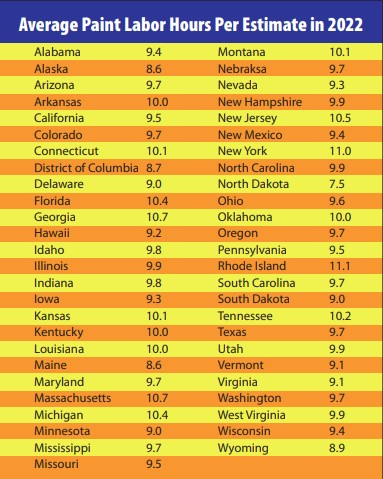Based on a question I received from an Autobody News reader, I’m going to focus my next couple of articles on refinish-related items I think you should know or think about.
For instance, as ADAS continues to become more prevalent, some automakers are saying an approved paint line needs to be used, because some paint products can affect the way blind spot monitors work behind a bumper. Nissan North America, for example, put out just this type of requirement for its ARIYA model. Similarly, Toyota put out a bulletin (CRIB #201) noting select 2023 Toyota and Lexus models use 77 Gigahertz (GHz) radar sensors, which require special refinish precautions that may mean the bumper cover cannot even be repainted.
So researching OEM repair procedures from a paint perspective is becoming very, very critical.
Now let’s talk about calculating reimbursement for paint materials. There continues to be two methods in our industry. There’s the traditional multiplier method, which is a set dollar rate multiplied by the number of refinish labor hours on the estimate or repair plan. If a job has 10 hours of paint labor and your material rate is, say, $40, you're going to get $400 for paint materials. That’s still the most widely used method, but that’s changing.
Our “Who Pays for What?” surveys over the past several years have found a growing percentage of shops using an invoicing system for paint materials---at least some of the time. There are several ways to produce an invoice for materials: a paint company’s mixing scale, Mitchell's Refinish Materials Calculator, PMC Logic, etc.
Which method makes the most sense for your shop may depend on your market. Paint material rates vary across the country. In some markets, the multiplier rate may be less than $30, while in others it’s $50 or higher.
So I think it's really important to understand there's not a one size-fits-all approach. But as we see more three- or four-stage paint, or more “limited use toners”---which tend to be expensive and not widely used, so generally not stocked in shops---it may make more sense to using invoicing versus the multiple method.
Paint materials profitability also requires writing solid repair plans, particularly if you are using the multiplier method. In the past, the benchmark was paint materials should account for about 10% of sales. But if you’re a shop that sublets out a lot of calibration or other ADAS work---which is a growing portion of the total repair cost---paint materials may now account for 8% or 9% of your total sales. Or if you repair a lot of high-end luxury vehicles, your parts bills may be higher, also reducing the percentage of sales for your paint materials.

So while I'm not saying you shouldn’t still benchmark paint materials as a percentage of sales, I think it’s also important to monitor the average number of refinish labor hours per repair order. As the state-by-state averages for paint labor hours shown in the table to the left demonstrate, there’s certainly a range for this. (The averages shown are for all insurance claims, both DRP and non-DRP combined.)
If you look at that data, you’ll see North Dakota is the lowest at 7.5 hours, and Rhode Island is the highest at 11.1 hours. Nationally, the average is 9.7 hours. But again, your mix of work can affect your average refinish hours per job. Are you doing more heavier hits or smaller jobs? Train wrecks versus dealership shipping damage or rental car parking lot damage?
That’s why another method to monitor this is by average paint labor hours per $1,000 in sales. The goal for that is typically about 2.7 paint labor hours for each $1,000 in sales. I recently ran a graph**** from our portal where we track the performance of many shops we consult with, and over the eight months, they were averaging between 2.03 and 2.16 average refinish hours per $1,000 in sales, and just under 11 refinish hours per repair order.
One other thing to keep in mind: If you’re doing a lot of smaller jobs without a lot of refinish labor hours, you may need to set a minimum you collect for paint materials per job. If a customer only needs a mirror replacement, you may only get an hour of refinish time, but that one hour times your multiplier rate may not adequately cover the cost of the refinish materials needed.
In my next article, I will discuss what's actually included in “materials,” both in the past versus what we see today, with more and more shops moving to itemize things on estimates and repair plans, including stock parts.














Mike Anderson